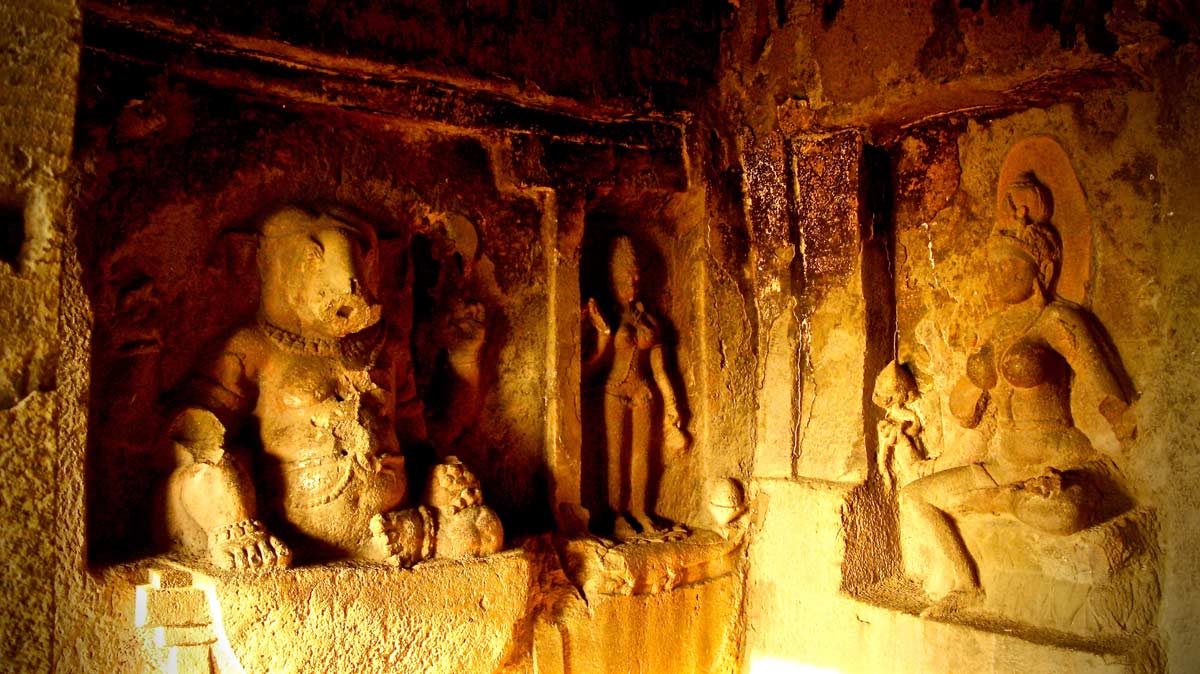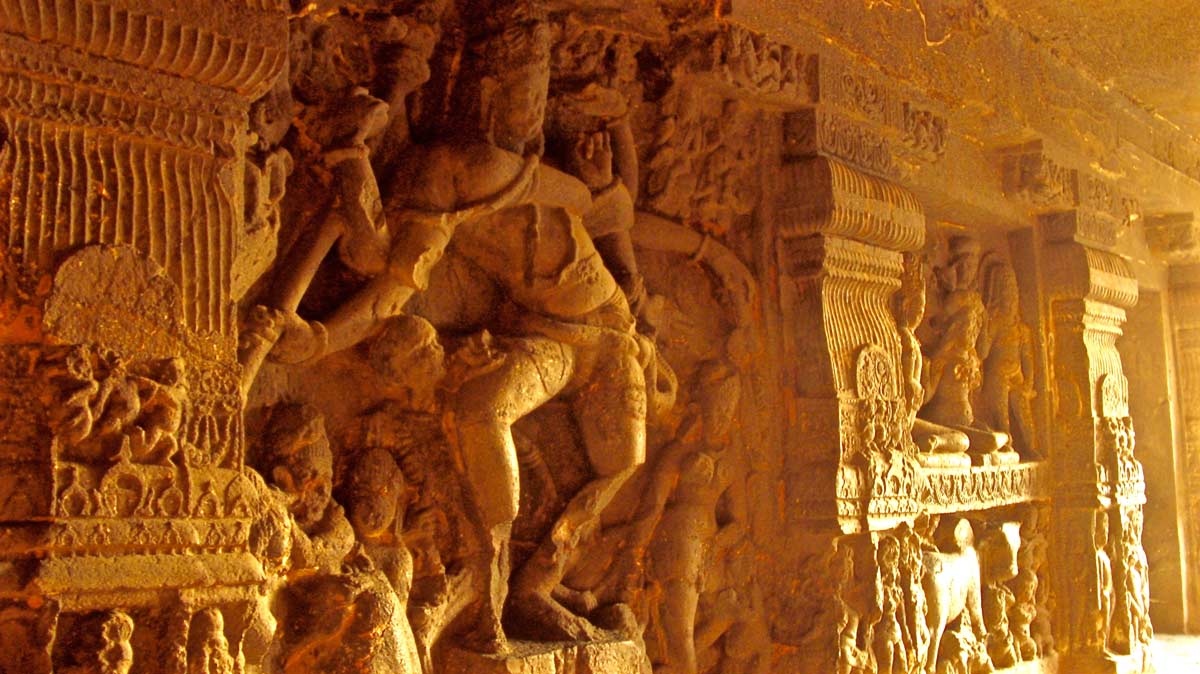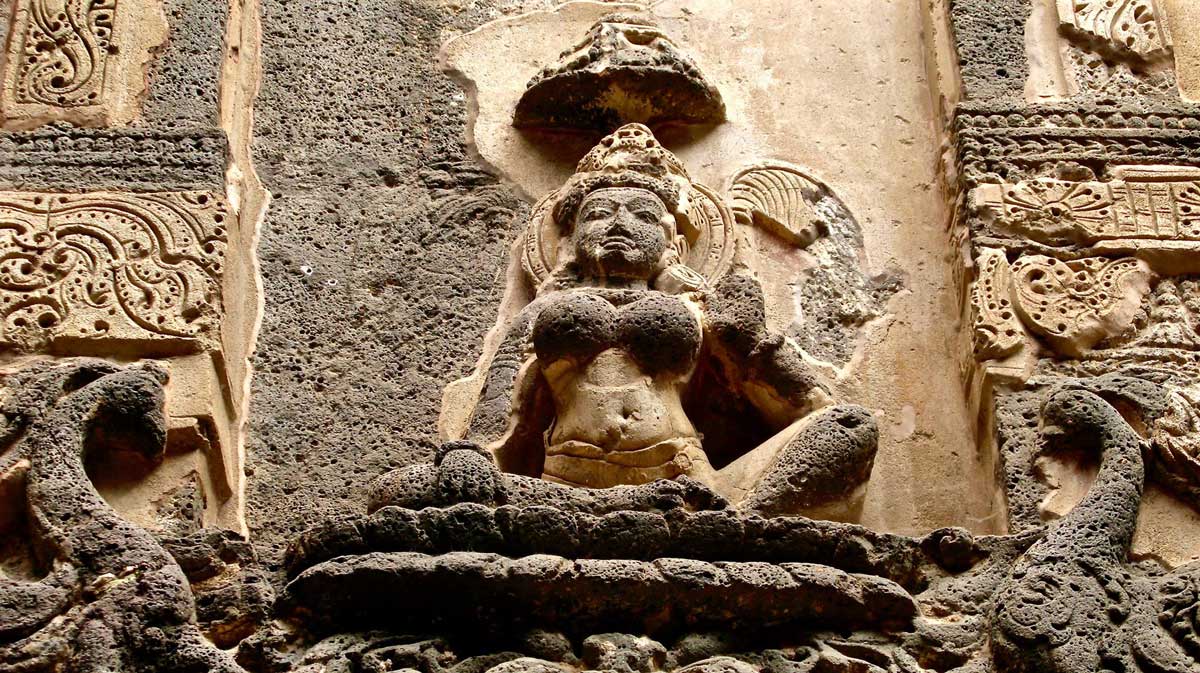Tantra in the Western imagination stands for exotic and orgasmic rituals coming from India and Tibet that blend sex and meditation. Tantric practice is
often compared with pagan animistic rituals that include blood and sex, and the supernatural powers described in Tantric texts are often compared with
magic. This does not mean that Tantra has always been painted positively in its homeland. For most native Indians, Tantra stands for scary witchcraft and
ghoulish Aghoris that capture the imagination when one thinks of a ‘Tantrik’. With the 20th century guru movements and the vacuum resulting from
a lack of traditional awareness, the ‘exotic’ side of Tantra appears to be in transit, doubling back to India in changed form.
Historically, Tantra has remained elastic in adopting practices that cannot be blended together to make one single practice or belief. The contemporary
categorization of Tantra subsumes this intrinsic diversity, with its practices contradictory to each other, and philosophies supporting different goals. As
Tantra becomes grossly simplified, the market that consumes Tantra is little concerned with the problems inherent to blending Hindu and Buddhist Tantras,
left-hand and right-hand Tantras, and various disciplines (Acharas). Once again, this homogenization is doubling back and attracting millions in
its homeland, mostly mixed with astrology and new-age beliefs.
Nowadays the Tantrics are less shy in proclaiming their identity, as this allows them to make a brand of themselves and be successful in selling spiritual orgasm.
There are reasons why the Tantric practitioners remained hidden in the homeland of Tantra and also why it has developed such a distinctive identity in the
West. In its history, Pashupatas, one distinctive school of Shiva worshippers, through their denial of social identity and their rejection of social
labels, exemplify the earliest tendency of Tantrics. The peculiar character of the Pashupatas to reject social identity and norms tends towards
deconstructing social identity and reflects the subject’s quest for liberation from socially constructed subjectivity. By demeaning themselves, they
believe, they can free themselves from their ego, desire, and attachment. This self-rejection, however, cannot be sold in the marketplace, if Tantra were
to be capitalized. Nowadays the Tantrics are less shy in proclaiming their identity, as this allows them to make a brand of themselves and be successful in
selling spiritual orgasm. The marketplace demands that Tantra’s unique ‘flavor’ be immediately recognizable.

Bringing Tantras to the West, in this light, is about selling spirituality in the marketplace.
Bringing Tantras to the West, in this light, is about selling spirituality in the marketplace. The practices that would otherwise take tens of years of
preparation are now to be purchased for a good sum of money. Relying upon post-modern ethics guided by capitalism and the missionary tendency of making
beliefs appealing (thus uniting globalization with free-market competition), religious value is determined by the marketplace, with its validity confirmed
on the basis of its marketability. Rewriting Tantras, in this light, demands response to these needs. There is no marketing for self-negation, and thus
Tantra becomes its opposite. Nobody would purchase some secretive meditative practices to be carried out in the forest or the cave, and thus Tantra becomes
hedonistic. The corporeal disciplines outlined in the Siddhanta texts become displaced, as Tantra has to discover itself in the post-1960s American
imagination. All the discussions regarding Tantras being Hindu or Non-Hindu have nothing to do with the history or practice of Tantra, as it now stems from
the desire to draw a bigger number of clients to the workshops. In other words, Tantra in the West is the encounter of ‘sacred sex’ as determined by
‘capitalistic ethics.’
There is no marketing for self-negation, and thus Tantra becomes its opposite.
Tantra in the West is the encounter of ‘sacred sex’ as determined by ‘capitalistic ethics.’
Reflection upon Tantra in the West can be more meaningful, if read within these parameters. The challenge now is to unravel what the Western individual
finds attractive in the ‘alien other’ of Tantra and what in this is repellent to the larger culture. Central to this is the atimarga or the
transgressive nature of the path that simultaneously constitutes the core of Tantra and makes Tantra alien to the West, for both Tantra-philes and
Tantra-phobes. With the many subgroups of Pasupatas, Kapalikas, Kalamukhas, Aghoris and so on, Tantra emerged as the path that contravenes regular codes
determining what is ‘religious’ and ‘ethical’ and embraces marginal paths, practices, rituals and philosophies, and worships violent and ecstatic forms.
This disregard for norms shatters the hegemony of the elite by sidelining what is considered pure and benevolent, and brings into the stream that which is
‘outside’ of the norm: the outcaste, the horrific and fearsome, the hidden and neglected. This reversal of the margin and center is not to reject the
existence of what lies at the center but simply to reject its centrality, breaking the code that rises from bottom to top, and to create a circular social
mandala, finding purity and divinity even in the entities that are otherwise considered impure. The simple pantheistic or monistic argument considers that
divinity is manifest in all forms and norms, and there is nothing that is not divine.
THE SECULAR EXPERIENCE

The first problem of bringing Tantra into discourse with the West rests in the nature and effect of the secular experience. Although Tantra is very liberal
in embracing all rituals, individuals, and divinities within its scope, it is not secular in terms of bringing experience from the realm of the sacred to
the mundane. Quite the contrary, there is nothing that is not ‘spiritually enlightening’ and not divine within the Tantric worldview. Selling spirituality
in the market is a midway through-point, as it on one hand demands the recognition of something that is spiritual, while on the other hand it assumes that
the objects or practices that can transform our experiences and turn them spiritual also hold market value. The universalization of Tantra that happened in
its homeland in classical times meant the deconstruction of social hierarchies and norms. The modern universalization of Tantra rests on the assumption
that everybody has the right to a piece of the Tantric pot of gold. The New Age faces the dilemma of reconciling these two opposite social realities, and
post-modern enlightenment is sanguine about its ability to commodify everything, including a commercialization of the divine.
To some extent, the secularization of Tantra can be compared to the process that secularized Yoga. The process of removing Yoga from its religious context
started in the early 1930s in India and received prominence in the West with multiple Yoga brands. Just as secularized Yoga stands for physical fitness,
secularized Tantra corresponds to hedonism, with orgies removed from social or mental boundaries.
Secrecy and marketing do not travel hand in hand. Tantric practices were mostly marginal, with secrecy remaining the norm.
The process of creating a marketplace, the appropriation of practices, the assimilation of archaic forms into the mainstream society and mixing with the
social imagination, all tend to constitute a peculiar flavor of the divine that can be achieved through money. The single-most obstacle in this chain of
transformation is the secretive character of Tantric practice. Secrecy and marketing do not travel hand in hand. Tantric practices were mostly marginal,
with secrecy remaining the norm. What is peculiar today is that we can google any form of Tantric practice, text, or visualization. It is not a select
group of people that participates in these hidden practices, but rather every individual is the consumer of the Tantras today. Between marketability and
the transformative power of esoteric practices, what survives today in the West is marketability. The challenge for a modern guru is not of finding a more
qualified student, but to reach out to the higher bidder, be it a group or an individual. Reality regarding the transformative powers of such practices is
determined by the expenses incurred for marketing and advertising them.
Between marketability and the transformative power of esoteric practices, what survives today in the West is marketability.
MAKING TANTRA MORE 'TANTRIC'
The discussion upon ‘Tantra in the West’ is not possible without exploring the Western imagination of non-Western culture. What is essential in this
analysis is to identify categories that have become prominent in recognizing the Western contribution to the popular imagination of Tantra. Among select
constituents, the foremost is the dynamics of the mystical ‘Orient,’ which can be analyzed along the Saïdian lines. The concept of the bipolarity of
‘rational’ and ‘mystical’ rests upon the supposition that the ‘Orient’ is mystical and therefore lacking in scientific knowledge or rationality. Although
various religious phenomena from the East - including Sufi mysticism, Vedanta, or Zen Buddhism - were introduced before Tantra emerged in the West, Tantra
most closely fits the Western imagination of the East, because among all forms of mysticism, Tantra introduces the most archaic elements. Even within this
paradigm, the Tantric practices of the Aghoris and Kapalikas match the Western imagination the most. An Aghori living in the cremation ground, consuming
human flesh along with hard liquor and opium, eating excrement, walking nude, appearing insane with rolling red eyes and incoherent shouts: all portray a
heathen savage unaware of the dawn of civilization. The early description of Tantra found in Western literature vividly portrays this imagination.
There is only a marginal difference between incorporating Tantra in the marketplace and teaching Tantra in the departments of South Asian Studies. The scholarly studies of Tantra demand that something Oriental is discovered in every membrane of secrecy embedded within the manuscripts, images, and ritual practices. Tantra in the marketplace demands that something orgasmic is revealed in every layer peeled away from the secretive garb of Tantra. In these parallel projects, what is discovered is the orgasmic ‘other’. Rather than reaching out to their colleagues in other departments, South Asianists tend to ‘understand’ India better by re-reading Max Muller and Sir William Jones, and in translating from some archaic texts. The scholarly fantasy of discovering the heart of India has set India aside, just as the spiritual marketing has saved everything of Tantra except for its power to transform human experience and grant liberation.

Talking about Tantra in the Western setting is also talking about orgasm. This is where the religious imagination of the West that stands in isolation of the body, gender, and sexuality parallels the West’s imagination of Tantra, which thus becomes the religion that is completely the opposite of what is considered ‘religious’. There can be nothing more irrational or ‘Otherly’ than blending sexuality and religion, as ‘sex’ in the Western religious landscape remains the consequence of forbidden fruit. The New Age has found Tantric practice liberating, within its own understanding or appropriation of sexuality.
A crucial element further embellished with the emergence of a ‘new’ Tantrism is its counter-cultural and anti-social aspect. Human beings share social
constructs to the extent that this negotiation does not endanger the individual’s autonomy to override the social and experience its individuality unbound
by social constructs. This may include the end of rationality and embody transgression. As socio-ethical norms are human constructs, this again becomes a
human possibility for the individual to liberate himself from the boundary that has been erected. The tension between the ‘social’ and ‘subjective’ aspects
of a human reflects this construction. Tantra, following this argument, is a need where the social overrides the subjective, where an individual strives to
find his liberation untrammeled by social conventions. Tantra of the Atimarga category possesses this disruptive character. What Tantra adds to this ‘anti-social’ aspect is the autonomous religious experience considered possible without relying upon any religious institutions or texts.
Abhinavagupta, the foremost Tantric theologian, claims that there are three sources of the gnosis that gives one self-realization: the mentor, the text,
and one’s self-experience. Interestingly, this classification of knowledge identifies self-experience as the highest. Now the scenario is, the vein in
which intuitive personal encounter was placed highest provides the theological justification for adapting practices and incorporating the bizarre forms
that support marketization. Giving self-experience centrality has its own counterculture role. All institutionalized religions face the dilemma of dealing
with human subjective experience: if the individuals are correct in recognizing their self-nature, then the institutions, the texts, and the tradition as
an integration of all these elements become irrelevant. The subjective quest for liberation stands in opposition to organized religion, as the individual’s
path allows the subject to seek his or her own salvation. In making Tantra a quest of self-discovery, there is also a thin line of balance. This process
can also challenge the market, because if subjects are free to explore their own spirituality, there is nothing that makes the products sold through
workshops inextricably essential. The anti-social character found in Tantra that offers liberation for which one does not need to rest upon religious
institution or scripture is preserved even in the wake of the Guru Movements, where the guru stands as the first and the last authority in granting
liberation. The guiding principle is, the authority of the guru is determined by their ability to sell themselves in the market. Something that can be sold
and purchased is true and those making the brands are the siddhas. In the process of accepting, changing, including, and renouncing gurus,
individuals arouse the very primitive instinct when humans first imagined the ‘divine.’ In institutionalized religions, it is not possible for one to
discover new gods or new scriptures, and the primitive instinct of projecting divinity is permanently subsumed. This is where Tantra finds itself
countercultural in displacing the boundaries in which the ‘spiritual’ is recognized. One fiction overrides the other. One collective fiction of religion
becomes controlled by the other, the money.

In this new cultural experience of Tantra in the West, there are two crucial domains interacting each other: the psychological and the social. The
psychological is the innate human condition that constitutes the sacred, that envisions the supernatural, and gives rise to animistic and pagan belief
forms. Although this facet of human imagination has been suppressed by the institutionalized forms of religion, it nevertheless remains layered within the
human psyche. Tantra, whether in the classical or modern times, provides a window for this need. In the societal level, Tantra has allowed an escape from
the norms, both in previous and contemporary settings. Whether or not Tantra remains liberating in its true sense, Tantra still provides basic
psychological needs of the individual and the collective.
Tantra is occasionally invoked to irk the pious Christian brothers. What could be more unnerving than the imagination of a witches’ circle with idolatry,
magic potions, debauchery, and the talisman? It is in this context that the most esoteric practice from the contemplative traditions comes to the
contemporary existential platform and discovers its social relevance. Tantra in this light stands for everything that the mainstream Western imagination of
religiosity stands against. Tantra in its homeland may not have evolved in reaction to orthodox Brahminism, as has been taught in the departments of South
Asian Studies. Tantras could have evolved through sustained contemplative practices, introduced by the practitioners who have themselves shunned the social
pressure and family ties. What makes Tantra interesting in modern times is the potential rediscovery – yet to be widely disseminated - that Tantra stands
for social revolution, a revolution against one imaginary society of the orientalists. Whether in the marketplace or in the classrooms, Tantra in the West
stands as an enigma. Bringing oriental practice into the society where institutionalized forms of religion do not allow for the possibility of worshipping
icons or murtis, performing magic rituals, or including exotic sexual practice within the realm of enlightening practice; all of these function as
revolutionary. In fact, any practice not grounded on monotheistic belief is transgressive to the common Western psyche.
In fact, any practice not grounded on monotheistic belief is transgressive to the common Western psyche.
The unraveling of Tantra as revolutionary demands that we read Tantra as a socio-economic tool, inflating the sacred from within. Rather than reading
Tantric transgressions as steps towards deconstructing self-identity, this new reading finds Tantric transgression relevant in challenging societal norms.
Implanting the social norms from one culture to another has a wide range of consequences. Drinking liquor, for instance, may have been transgressive in
classical Hindu-Buddhist society where purity is maintained by refraining from drinking liquor. There is nothing transgressive about drinking wine in the
West. The sex-codes imposed in classical Indian society may not be applicable in the Western settings either. The reinvention of Tantra in the West
therefore demands that something be invented from within Tantra that transgresses the social codes in the West. In this regard, everything coming from
India is Tantric, as this carries a peculiar alien flavor.
The Tantric injunction to transcend its own rules also applies in the case of modernity. Modernity not only has the ability to deconstruct old values, it
also has the self-reflexive ability to break itself down.
This fits with the argument that while Tantra may endorse liberal values, it does not establish
secular values, but just the reverse, it spiritualizes all modes of experience. What remains non-negotiable between these two is the capitalistic value
wherein a human possesses real independence through the accumulation of capital, making it possible for an individual to purchase commodities, whereas in
Tantra, its fundamental value rests in its endorsement of divinity in all forms, eliminating the profane from the horizon of existence.